As I pack away my Christmas tree for another year, I took stock today of my Christmas haul of books. I’m planning on reading more classics in 2015 and was fortunate enough to receive a few beautiful clothbound editions for Christmas. I hope you too were lucky enough to receive a book or two at Christmas time, […]
Add a CommentViewing: Blog Posts Tagged with: Frankenstein, Most Recent at Top [Help]
Results 1 - 25 of 39
Blog: Perpetually Adolescent (Login to Add to MyJacketFlap)
JacketFlap tags: Tracey Allen, haul, john howard, The Menzies Era, Book News, classics, Stephen King, Christmas Books, Holiday Reading, james patterson, John Steinbeck, Pulitzer Prize, Oscar Wilde, dean koontz, frankenstein, mary shelley, the picture of dorian gray, robinson crusoe, penguin classics, Daniel Defoe, Add a tag
Blog: OUPblog (Login to Add to MyJacketFlap)
JacketFlap tags: Books, Young Adult Literature, Literature, fiction, Twilight, gothic, Wonder, Frankenstein, The Hunger Games, eighteenth-century, english literature, Gothic Literature, *Featured, Sublime, gothic horror, Arts & Humanities, Eighteenth Century Fiction, Eighteenth-Century Fiction and the Reinvention of Wonder, Sarah Kareem, Add a tag
Recently I was talking to a younger colleague, a recent PhD, about what we and our peers read for pleasure. He noted that the only fiction that most of his friends read is young adult fiction: The Hunger Games, Twilight, that kind of thing. Although the subject matter of these series is often dark, the appeal, hypothesized my colleague, lies elsewhere: in the reassuringly formulaic and predictable narrative arc of the plots. If his friends have a taste for something genuinely edgy, he went on, then they’ll read non-fiction instead.
When did we develop this idea that fiction, to be enjoyable, must be comforting nursery food? I’d argue that it’s not only in our recreational reading but also, increasingly, in the classroom, that we shun what seems too chewy or bitter, or, rather; we tolerate bitterness only if it comes in a familiar form, like an over-cooked Brussels sprout. And yet, in protecting ourselves from anticipated frictions and discomforts, we also deprive ourselves of one of fiction’s richest rewards.
One of the ideas my research explores is the belief, in the eighteenth-century, that fiction commands attention by soliciting wonder. Wonder might sound like a nice, calm, placid emotion, but that was not how eighteenth-century century thinkers conceived it. In an essay published in 1795 but probably written in the 1750s, Adam Smith describes wonder as a sentiment induced by a novel object, a sentiment that may be recognized by the wonderstruck subject’s “staring, and sometimes that rolling of the eyes, that suspension of the breath, and that swelling of the heart” (‘The Principles Which Lead and Direct Philosophical Enquiries’). And that was just the beginning. As Smith describes:
“when the object is unexpected; the passion is then poured in all at once upon the heart which is thrown, if it is a strong passion, into the most violent and convulsive emotions, such as sometimes cause immediate death; sometimes, by the suddenness of the extacy, so entirely disjoint the whole frame of the imagination, that it never after returns to its former tone and composure, but falls either into a frenzy or habitual lunacy.” (‘The Principles Which Lead and Direct Philosophical Enquiries’)
It doesn’t sound very comfortable, does it? Eighteenth-century novels risked provoking such extreme reactions in their tales of people in extremis; cast out; marooned; kidnapped. Such tales were not gory, necessarily, in the manner of The Hunger Games, and the response they invited was not necessarily horror or terror. More radically, in shape and form as well as content, eighteenth-century writers related stories that were strange, unpredictable, unsettling, and, as such, productive of wonder. Why risk discomforting your reader so profoundly? Because, Henry Home, Lord Kames argued in his Elements of Criticism (1762), wonder also fixes the attention: in convulsing the reader, you also impress a representation deeply upon her mind.

One of the works I find particularly interesting to think about in relation to this idea of wonder is Mary Shelley’s 1818 novel Frankenstein. Frankenstein is a deeply pleasurable book to read, but I wouldn’t describe it as comfortable. Perhaps I felt this more acutely than some when I first read it, as a first year undergraduate. The year before I had witnessed my father experience a fatal heart attack. Ever since then, any description or representation that evoked the body’s motion in defibrillation would viscerally call up the memory of that night. One description that falls under that heading is the climactic moment in Shelley’s novel in which Victor Frankenstein brings his creature to life: “I saw the dull yellow eye of the creature open; it breathed hard, and a convulsive motion agitated its limbs.” If the unexpected, in Smith’s account, triggers convulsive motions, then it seems fitting that a newly created being’s experience of its own first breath would indeed be felt as a moment of wonder.
When I was a nineteen year-old reading Frankenstein, there was no discussion about the desirability of providing “trigger warnings” when teaching particular texts; and even if there had been, it seems unlikely that this particular text would have been flagged as potentially traumatic (a fact that speaks to the inherent difficulty of labeling certain texts as more likely to serve as triggers than others, given the variety of people’s experience). I found reading Shelley’s novel to be a deeply, uncomfortably, wonder-provoking experience, in Smith’s terms, but it did not, clearly, result in my “immediate death.” What it did produce, rather, was a deep and lasting impression. Indeed, perhaps that is why, more than twenty years later, I felt compelled to revisit this novel in my research, and why I found myself taking seriously Percy Shelley’s characterization of the experience of reading Frankenstein as one in which we feel our “heart suspend its pulsations with wonder” at its content, even as we “debate with ourselves in wonder,” as to how the work was produced. High affect can be all consuming, but we may also revisit and observe, in more serene moments, the workings of the mechanisms which wring such high affect from us.
In Minneapolis for a conference a few weeks ago, I mentioned to my panel’s chair that I had run around Lake Calhoun. He asked if I had stopped at the Bakken Museum (I had not), which is on the lake’s west shore. He proceeded to explain that it was a museum about Earl Bakken, developer of the pacemaker, whose invention was supposedly inspired by seeing the Boris Karloff 1931 film of Frankenstein, and in particular the scene in which the creature is brought to life with the convulsive electric charge.
As Bakken’s experience suggests, the images that disturb us can also inspire us. Mary Shelley affirms as much in her Introduction to the 1831 edition of the novel, which suggests that the novel had its source in a nightmarish reverie. Shelley assumes that Frankenstein’s power depends upon the reproducible nature of her affect: “What terrified me will terrify others,” she predicts. Haunting images, whether conjured by fantasies, novels, or films, can be generative, although certainly not always in such direct and instrumental ways. Most of us won’t develop a life-saving piece of technology, like Earl Bakken (my father, in fact, had a pacemaker, and, although it didn’t save his life, it did prolong it) or write an iconic novel, like Mary Shelley. But that is not to say that the impressions that fiction can etch into our minds are not generative. If comfort has its place and its pleasures, so too does discomfort: experiencing “bad feelings” enables us to notice, in our re-tracings of them, the unexpected connections that emerge between profoundly different experiences—death; life; reading—all of them heart-stopping in their own ways.
The post Heart-stopped: Fiction and the rewards of discomfort appeared first on OUPblog.
Blog: Illustration for Kids Blog (Login to Add to MyJacketFlap)
JacketFlap tags: Illustration, cartoon, comic, ghost, trick or treat, paula j. becker, paula becker, Frankenstein, devil, haunted house, mummy, #halloween, #hauntedhouse, #paulajbecker, #trickortreat, children's illustraton, Add a tag
Blog: Whateverings (Login to Add to MyJacketFlap)
JacketFlap tags: Links, halloween, kids, cute, cartoon, comic, General Illustration, children's illustration, Samples, witch, vampire, ghost, funny, pumpkin, trick or treat, paula j. becker, dracula, paula becker, black cat, bats, spider, frankenstein, werewolf, haunted house, mummy, Cartoons & Comics, graveyard, Add a tag
It’s been a while since I updated! Time to do so, and I’ll begin with a Halloween piece I worked on recently. The main piece and closeups are below. I can always add and tweak, but there is a time to call an illustration “Done!” Happy Halloween, everyone!
Blog: Perpetually Adolescent (Login to Add to MyJacketFlap)
JacketFlap tags: art, frankenstein, mary shelley, Lord Byron, affirm press, siri hustvedt, Book Reviews - Fiction, alex miller, Joy Lawn, Autumn Laing, Blazing World, Emily Bitto, Percy Shelley, The Strays, Victorian Premier's Literary Award, Add a tag
Who are the strays in Emily Bitto’s literary novel, The Strays (Affirm Press)? The new Melbourne Modern Art Group tries to set up a bohemian utopia paralleling Sunday and John Reed’s Heide group, or Norman Lindsay’s enclave, on affluent Evan and Helena Trentham’s property during the Depression. Patrick is a stalwart and Ugo, Maria and […]
Add a CommentBlog: OUPblog (Login to Add to MyJacketFlap)
JacketFlap tags: *Featured, Arts & Humanities, History, Literature, gothic, dracula, British, Nosferatu, Frankenstein, Oxford World's Classics, Bela Lugosi, The Cabinet of Dr Caligari, boris karloff, Nick Groom, The Castle of Otranto, Add a tag
This year is the 250th anniversary of Horace Walpole’s The Castle of Otranto, first published on Christmas Eve 1764 as a seasonal ghost story. The Castle of Otranto is often dubbed the “first Gothic novel” due to Walpole describing it as a “Gothic story,” but for him the Gothic meant very different things from what it might do today. While the Gothic was certainly associated with the supernatural, it was predominantly a theory of English progress rooted in Anglo-Saxon and medieval history — effectively the cultural wing of parliamentarian politics and Protestant theology. The genre of the “Gothic novel,” with all its dire associations of uncanny horror, would not come into being for at least another century. Instead, the writing that followed in the wake of Otranto was known as the German School, the ‘Terrorist System of Writing’, or even hobgobliana.
Reading Otranto today, however, it is almost impossible to forget what 250 years of Gothickry have bequeathed to our culture in literature, architecture, film, music, and fashion: everything from the great Gothic Revival design of the Palace of Westminster to none-more-black clothes for sale on Camden Town High Street and the eerie music of Nick Cave, Jordan Reyne, and Fields of the Nephilim.
And the cinema has been instrumental in spreading this unholy word. Despite being rooted in the history of the barbarian tribes who sacked Rome and the thousand-year epoch of the Dark Ages, the Gothic was also a state-of-the-art movement. Technology drove the Gothic dream, enabling, for instance, the towering spires and colossal naves of medieval cathedrals, or enlisting in nineteenth-century art and literature the latest scientific developments in anatomy and galvanism (Frankenstein), the circulation of the blood and infection (The Vampyre), or drug use and psychology (Strange Case of Dr Jekyll and Mr Hyde).
The moving image on the cinema screen therefore had an immediate and compelling appeal. The very experience of cinema was phantasmagoric — kaleidoscopic images projected in a darkened room, accompanied by often wild, expressionist music. The hallucinatory visions of Henry Fuseli and Gustave Doré arose and, like revenants, came to life.

Camera tricks, special effects, fantastical scenery, and monstrous figures combined in a new visual style, most notably in Robert Wiene’s The Cabinet of Dr Caligari (1920) and F. W. Murnau’s Nosferatu: A Symphony of Terror (1922). Murnau’s Nosferatu, the first vampire film, fed parasitically on Bram Stoker’s Dracula; it was rumored that Max Schreck, who played the nightmarish Count Orlok, was indeed a vampire himself. The horror film had arrived.

Mid-century Hollywood movie stars such as Bela Lugosi, who first played Dracula in 1931, and Boris Karloff, who played Frankenstein’s monster in the same year, made these roles iconic. Lugosi played Dracula as a baleful East European, deliberately melodramatic; Karloff was menacing in a different way: mute, brutal, and alien. Both embodied the threat of the “other”: communist Russia, as conjured up by the cinema. Frankenstein’s monster is animated by the new cinematic energy of electricity and light, while in Dracula the Count’s life and death are endlessly replayed on the screen in an immortal and diabolical loop.
It was in Britain, however, that horror films really took the cinema-going public by the throat. Britain was made for the Gothic cinema: British film-makers such as Hammer House of Horror could draw on the nation’s rich literary heritage, its crumbling ecclesiastical remains and ruins, the dark and stormy weather, and its own homegrown movie stars such as Peter Cushing and Christopher Lee. Lee in particular radiated a feral sexuality, enabling Hammer Horror to mix a heady cocktail of sex and violence on the screen. It was irresistible.
The slasher movies that have dominated international cinema since Hammer through franchises such as Hellraiser and Saw are more sensationalist melodrama than Gothic, but Gothic film does thrive and continues to create profound unease in audiences: The Exorcist, the Alien films, Blade Runner, The Blair Witch Project, and more overtly literary pictures such as Bram Stoker’s Dracula are all contemporary classics — as is Buffy the Vampire Slayer on TV.
And despite the hi-tech nature of film-making, the profound shift in the meaning of Gothic, and the gulf of 250 years, the pulse of The Castle of Otranto still beats in these films. The action of Otranto takes place predominantly in the dark in a suffocatingly claustrophobic castle and in secret underground passages. Inexplicable events plague the plot, and the dead — embodying the inescapable crimes of the past — haunt the characters like avenging revenants. Otranto is a novel of passion and terror, of human identity at the edge of sanity. In that sense, Horace Walpole did indeed set down the template of the Gothic. The Gothic may have mutated since 1764, it may now go under many different guises, but it is still with us today. And there is no escape.
The post “There is no escape.” Horace Walpole and the terrifying rise of the Gothic appeared first on OUPblog.
Blog: RabbleBoy (Login to Add to MyJacketFlap)
JacketFlap tags: Book Reviews, robots, comics, steampunk, frankenstein, steam punk, greg wright, ken lamug, hire power, monstrous, Add a tag
Over the last month, I’ve been working with Greg Wright on a new comic book project called “Monstrous”.
It’s got steam powered robots & monsters that span the imagination. In this pilot, we meet a little girl who has to team up with a monster for hire to avenge her father’s death. What I love about MONSTROUS, is that it has the “IT” factor that I believe will be enjoyed by young and old. It has fun moments, scary moments and head turning moments.
Sometimes I wish could just read the entire series already instead of having to create it. It’s not that I don’t enjoy working on it (trust me – it’s a blast)… it’s the fact that I have to wait on my slow butt to finish it. Ha!
Add a CommentBlog: Perpetually Adolescent (Login to Add to MyJacketFlap)
JacketFlap tags: Music, literature, art, Pop Culture, Wuthering Heights, dracula, frankenstein, John Keats, Percy Bysshe Shelley, Lord Byron, Weezer, My Chemical Romance, AFI, AC/DC, Book Reviews - Non-Fiction, 1001 Books you must read before you die, craig schuftan, Entertain Us, Fredrich Nietzsche, Hey! Nietzche! Leave Them Kids Alone!, The Culture Club, The Romantic Movement, Triple J, Add a tag
 I’m not really interested in giving people a quick introduction; I tend to mix my personal life, humour, sarcasm and knowledge into my book reviews and blog posts. However I do want to kick off talking about the book that turned me into a reader. It wasn’t until 2009 that I discovered the joys of books and reading and something inside me clicked and I wanted to consume every book I saw. This life changing event was all because of one book, an Australian non-fiction title called Hey! Nietzsche! Leave Them Kids Alone! by Craig Schuftan.
I’m not really interested in giving people a quick introduction; I tend to mix my personal life, humour, sarcasm and knowledge into my book reviews and blog posts. However I do want to kick off talking about the book that turned me into a reader. It wasn’t until 2009 that I discovered the joys of books and reading and something inside me clicked and I wanted to consume every book I saw. This life changing event was all because of one book, an Australian non-fiction title called Hey! Nietzsche! Leave Them Kids Alone! by Craig Schuftan.
At the time I listened to a lot of music and would have cited AFI, My Chemical Romance, Weezer, and so on as some of my favourite bands. In face I was right into the music that was been played on Triple J. Craig Schuftan was a radio producer at Triple J at the time and there was a short show he made for the station called The Culture Club. In this show he would talk about the connection rock and roll has to art and literary worlds. Friedrich Nietzsche was claiming, “I am no man, I am dynamite” well before AC/DC’s song TNT.
That was a real revelation for me and I picked up Hey! Nietzsche! Leave Them Kids Alone! (subtitled; The Romantic Movement, Rock and Roll, and the End of Civilisation as We Know It) and began reading it. However it didn’t stop there; this book connected the so called ‘emo’ movement with The Romantic Movement, I never thought these bands would have anything in common with the greats like Lord Byron, Percy Bysshe Shelley or John Keats but I had to find out.
Hey! Nietzsche! Leave Them Kids Alone! by Craig Schuftan ended up taking half a year to complete; not because I was a slow reader but I wanted to know more,and I read poetry by Lord Byron, Percy Bysshe Shelley and John Keats, and researched online. I picked up books like Frankenstein (an obsession of mine), Dracula and Wuthering Heights just because they were mentioned. This was a weird turn in my life but my growing thirst for knowledge became an obsession with reading. I have now set a life goal to read everything on the 1001 Books you must read before you die list.
It is weird to think one book can have such a huge impact on my life but I credit Craig Schuftan (and my wife) for such a positive improvement in my life. I will eventually read Craig Schuftan’s books The Culture Club: Modern Art, Rock and Roll and other stuff your parents warned you about and Entertain Us!: The Rise and Fall of Alternative Rock in the Nineties but I’ve put them off because I suspect the same amount of research will be involved.
Has a book had such a positive impact in your life? I would love to know in the comments. Also are there any other books that explore the connections between art and literature with pop-culture?
Add a CommentBlog: Kid Lit Reviews (Login to Add to MyJacketFlap)
JacketFlap tags: Capstone, Stone Arch Books, 4stars, Library Donated Books, Scott Sonneborn Timothy Banks, Children's Books, family, relationships, Series, Books for Boys, relatives, Frankenstein, Early Reader, mad scientists, Add a tag
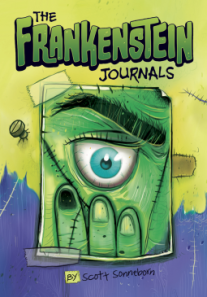 The Frankenstein Journals: Feet First & I for an Eye
The Frankenstein Journals: Feet First & I for an Eye
by Scott Sonneborn
Illustrated by Timothy Banks
Stone Arch Books 8/01/2014
978-1-4342-9130-1
Age 7 to 10 160 pages
.
“In this combination of two separately published works, J.D. discovers that he is the son of Frankenstein’s monster, and armed with the Doctor’s journal he sets out to find his “relatives”—the descendants and relations of the people whose body parts Doctor Frankenstein used.”
Opening
“BORRRRING. That’s how I’d describe the first 13 years of my life.”
The Story
J.D. has lived at Mr. Shelley’s orphanage for Lost and Neglected Children since he was an infant and Mr. Shelley found him in a box. Now, at age 14, J.D.—short for John Doe—is on his own, the orphanage closed. J.D. is trying to find his family. His one lead is a book left in the box when he was an infant. It is a journal and in it is a picture of J.D. as an infant being held by his father—Frankenstein! J.D. had always dreamt he was part of a large family. Using the journal entries J.D. is trying to track down his family, but so his someone else.
Feet First begins J.D.’s journey from orphan to family-finder. J.D. meets Fran, daughter of Dr. Frankenstein. Deranged like her father, Fran thinks of nothing else but making her own improved monster, but nothing has worked. She now wants to use the same DNA dad used which has her on the trail of the same people J. D. is looking for, but J.D. is trying to connect as family. The first is explorer Robert Percy, currently at the end of the world.
I for an Eye: Fran Kenstein is still trying to find the relatives of those people her father used to make Frankenstein, J.D.’s father. J.D. is trying to get to his cousins first, to warn them of the danger called Fran. Now is Los Angeles, J.D. is looking for the grandson of Samuel “Clew” Hammer, a private detective in 1940. Hammer’s green eye became Frankenstein’s left eye. Before J.D. could get very far Fran shows up, gets J.D. thrown into jail, and leaves to go after all his cousins in L.A.
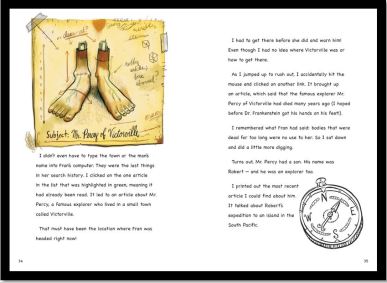
Review
J.D.’s journey will take a few books so it’s a good thing The Frankenstein Journals is a new series. If you liked Hotdogger, you’ll like The Frankenstein Journals. J.D. tells the story as it happens and scenes rush by. Even this two-story edition was a breeze. Reluctant readers will like this. The action is fast, the story has only what is needed. There are no slow sections that might bog a reader.
Frankenstein’s son looks a lot like his father, with odd shaped hands and feet, and two colors for his eyes, but he is a determined kid, fighting against time and Fran who is anxious to find the same people and lure them back for her experiment. There are illustrations throughout the book, some a full page, some in color. The hand-printed font, in various sizes, shapes, and colors, usually express an unexpected emotion caused by new information about J. D’s family. The book is visually appealing.
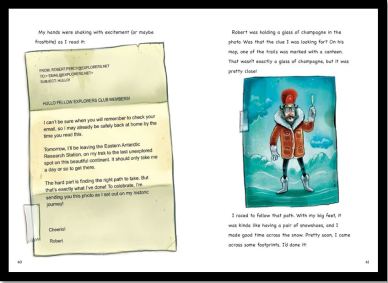
The only thing I do not like are the spaces between paragraphs, as if written on the Internet. This series is a chapter book series for young readers. This is not the time to forget about proper writing, especially when there is no benefit to having these paragraphs spaced incorrectly. At least the paragraphs are indented.
I think boys will like The Frankenstein Journals because of the fast action, a male slant on the stories, thus far, and the crazy illustrations and graphics. The female presence in the story is evil, just as boys this age probably see their female classmates. In a twist, Fran has no interest in J.D., but he instantly falls for Fran, misreading all of her words and actions, just like a lovesick girl would. J.D. no longer has a crush on Fran, having figured out her evil plan. Maybe girls age 7 to 12 age are evil, not just yucky.
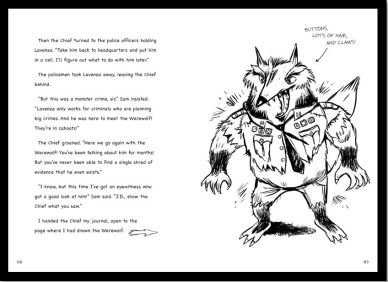
Girls might also like the story of J.D. reclaiming his family. The main character is a sweet young boy searching the ends of the earth, literally—trying to find an unknown number of relatives before evil Fran finds them and makes a new Frankenstein out of them. If you like stories with twists and turns, and the occasional body part, The Frankenstein Journals would be a great series to start reading. Pre-order today for the August release date.
THE FRANKENSTEIN JOURNALS: FIRST FEET and I FOR AN EYE. Text copyright © 2014 by Scott Sonneborn. Illustrations copyright © 2014 by Timothy Bans. Reproduced by permission of the publisher, Stone Arch Books, an imprint of Capstone, North Mankato, MN.
Learn more about The Frankenstein Journals HERE.
Pre-order a copy of The Frankenstein Journals at Amazon—B&N—Capstone—your local bookstore.
.
Meet author, Scott Sonneborn at his website: http://scottsonneborn.com/
Meet illustrator, Timothy Banks at his website: http://timothybanks.com/
Find more Stone Arch Books at the publisher’s website: http://www.capstonepub.com/category/LIB_PUBLISHER_SAB
.
Also by Scott Sonneborn
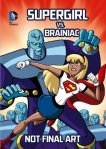
Supergirl vs. Brainiac
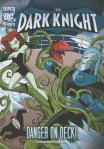
Danger on Deck!…
.
.
.
.
.
.
Also by Timothy Banks
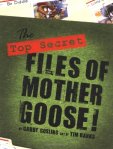
The Top Secret Files of Mother Goose!
.
.
.

Filed under: 4stars, Books for Boys, Children's Books, Early Reader, Library Donated Books, Series Tagged: Capstone, family, Frankenstein, mad scientists, relationships, relatives, Scott Sonneborn Timothy Banks, Stone Arch Books
Blog: Stacy A. Nyikos (Login to Add to MyJacketFlap)
JacketFlap tags: Science Fiction, Star Trek, Star Wars, space, Mars, Frankenstein, Tor, Mary Shelley, Andy Weir, The Martian, Add a tag
The Martian
Andy Weir
Science Fiction - Adult
Pop quiz:
1) Do you ever stare at the night sky wondering if there is life out there?
2) Ever tried to levitate something with your mind?
3) Have you ever secretly (or not so secretly) watch Star Trek?
Houston, we have lift off. You like science fiction!
Science fiction has been fascinating readers from the moment Mary Shelley brought Frankenstein's monster to life. And writers of science fiction have been working to keep their edge ever since that first breath of life into their genre. Today, they're getting a little help from actual, real life physicists. Science fiction has become your basic rocket science.
How can this be? Some brilliant people at Tor had the great idea to pair up science fiction writers with NASA scientists. The result is a new list of science fiction titles, headed up by Andy Weir's, The Martian.
Basic premise: Robinson Crusoe on Mars.
More details: Mark Watney, a member of the Ares 3 Mars crew, accidentally gets left on Mars during the middle of a sandstorm. He has a habitat. He has oxygen and water. He has some food. But he doesn't have enough to last until the next Ares mission arrives. Cue creativity. How will Mark survive? Will NASA be able to help?
Weir's characters are wonderfully diverse and wickedly smart without being so smart they become inaccessible. The plot is scary believable. Accidents can happen, especially on a mission to a place as far away and foreign as Mars. The scientific does not way down the story, but rather, enhance it. Admittedly, there were moments when I did zone a little. Then again, that could have been the elliptical machine getting the better of me. I have books I "save" for work outs only. This was one. But I found myself sneaking more of The Martian whenever I could, like a secret stash of chocolate. And more than once that I had to remind myself this is NOT REAL. It's "just" a story (so stop crying!).
Tor has more books in the line up. One is about an elevator from earth to the international space station. Finally, a true fix for my science fiction addiction. I can't wait to see what they imagine up next. And...um...if it's not too much to ask, does anyone know how to get in the super secret society of writers who get to work with these amazing scientists?
For more April fling reads, check out Barrie Summy's website!
Add a Comment
Blog: The Pen Stroke | A Publishing Blog (Login to Add to MyJacketFlap)
JacketFlap tags: Sutton, Carlos Ruiz Zafón, A Monster Calls, The Shadow of the Wind, 50 Book Pledge, Andrew Westoll, The Chimps of Fauna Sanctuary, 100 Selected Poems, E. E. Cummings, The Savvy Reader, Books, Frankenstein, Mary Shelley, Patrick Ness, J.R. Moehringer, Add a tag
| 50 Book Pledge | Book #51: Sutton by J.R. Moehringer |
 I’m ecstatic to report that as of Monday, October 8, 2012, I turned the final page on my 50 Book Pledge. For those doing the math, that’s nine months, seven days, eleven hours and twenty-eight minutes.
I’m ecstatic to report that as of Monday, October 8, 2012, I turned the final page on my 50 Book Pledge. For those doing the math, that’s nine months, seven days, eleven hours and twenty-eight minutes.
I still can’t believe I did it because when I first set out I wasn’t entirely convinced I could. I considered fifty books in fifty-two weeks a tall order, especially since I’ve never read that many books in a single year before. My greatest fear could be summed up in a single word: Time.
What a fool I was. Time wasn’t a factor at all. In fact, my biggest dilemma ended up being what to read next. But, obviously, that didn’t last very long.
| By the Numbers |
| 3 # of non-fiction books I read |
4 # of classics I read
2 # of series I started
3 # of poetry books I read
1 # of books I stopped reading
15 # of books I read by HarperCollins Canada
43 # of authors I read for the first time
The amazing part about participating in the pledge was how it turned me into a literary monster. With every book I finished, I found that my hunger for reading grew exponentially. I couldn’t get enough! In the words of George R.R. Martin the reader in me wanted to live “a thousand lives.” (Now I’ve only got 950 to go.) And that’s precisely why I’m going to continue reading and why I’ll be taking the pledge again next year.
Looking back it’s hard to pick a favourite because I read some truly phenomenal books. Instead, here’s just a small sampling of books that knocked my socks off:
Now that I had finished, the beauty of my dream vanished, and breathless horror and disgust filled my heart …
The Chimps of Fauna Sanctuary by Andrew Westoll
Dignity begins when an animal feels that she is the chief instrument of change in her life.
100 Selected Poems by e.e. cummings
i like my body when it is with your body.
It is so quite new a thing.
Muscles better and nerves more.
 A Monster Calls by Patrick Ness
A Monster Calls by Patrick Ness
This monster is something different, though. Something ancient, something wild. And it wants the most dangerous thing of all from Conor.
It wants the truth.
The Shadow of the Wind by Carlos Ruiz Zafón
Once, in my father’s bookshop, I heard a regular customer say that few things leave a deeper mark on a reader than the first book that finds its way into his heart. Those first images, the echo of words we think we have left behind, accompany us throughout our lives and sculpt a palace in our memory to which, sooner or later—no matter how many books we read, how many worlds we discover, or how much we learn or forget—we will return.
A huge thank you to The Savvy Reader for making 2012 the best reading year of my life!
Blog: The Winged Elephant (Login to Add to MyJacketFlap)
JacketFlap tags: monster, frankenstein, mary shelley, marquis de sade, dave zeltserman, caretaker of lorne field, a killer's essence, Add a tag
Dave Zeltserman, author of the newly published Monster: A Novel of Frankenstein, as well as A Killer's Essence and The Caretaker of Lorne Field, talks to The Winged Elephant: What originally drew you to the Frankenstein story? When I was a kid I grew up thinking that the Frankenstein novel was the same as the Boris Karloff movie. When I was in high school I heard that the novel is very
Blog: The Pen Stroke | A Publishing Blog (Login to Add to MyJacketFlap)
JacketFlap tags: Frankenstein, Mary Shelley, This Dark Endeavour, The Chimps of Fauna Sanctuary, Kenneth Oppel, My Bookshelf, 50 Book Pledge, Andrew Westoll, HarperCollins Canada, The Apprenticeship of Victor Frankenstein, Add a tag
50 Book Pledge | Book #7: The Chimps of Fauna Sanctuary by Andrew Westoll
For your reading pleasure, I present HarperCollins Canada‘s This Dark Endeavour by Kenneth Oppel.
Let me begin by saying that I was skeptical about reading This Dark Endeavour. Here’s why: I read Mary Shelley’s Frankenstein first and I was in awe of her masterpiece. I couldn’t see how Kenneth Oppel, or any writer, could do justice to the most well-known work of horror fiction in literature. However, the truth is, that This Dark Endeavour: The Apprenticeship of Victor Frankenstein was phenomenal.
For me, Oppel’s greatest achievement is the foundation he builds for Shelley’s Frankenstein. The stepping stones he lays are not only believable but also insightful. There’s nothing that’s straightforward about young Victor Frankenstein. In fact, he’s a complicated mess. He doesn’t quite know what it is that drives him. Thus, his personal struggle is absolutely engrossing. Readers of all ages will undoubtedly relish every gripping page of Oppel’s masterful prequel.
This Dark Endeavour is the definition of must-read.
Blog: Whateverings (Login to Add to MyJacketFlap)
JacketFlap tags: Links, halloween, comics, cartoon, General Illustration, card, frankenstein, mummy, Cartoons & Comics, wolfman, Add a tag
Posting some cartoons (that I’ve always liked) from a Halloween greeting card I did a few years back…
Blog: A Cartoonist Rambles- Humorous Illustrations and Cartoons Designs from Marty Qatani (Login to Add to MyJacketFlap)
JacketFlap tags: cute, Dog, Character Design, Frankenstein, cartoon character, Mutt, Cartoon Monster, Halloween Character, Marty Qatani, Martytoons, Humorus Illustration, Add a tag
Blog: Claudsy's Blog (Login to Add to MyJacketFlap)
JacketFlap tags: Bible, Writing and Poetry, Frankenstein, Mary Shelley, Lord Byron, John William Polidori, Yahoo! News, Texas State University–San Marcos, Villa Diodati, Add a tag
Astronomers released a new report this past week. http://news.yahoo.com/under-frankenstein-moon-astronomer-sleuths-solve-mary-shelley-201601341.html/
Rumor has it that these researchers play with scientific private investigation in their spare time. They snag one literary allusion at a time, hoping to find the possible authentic astronomical event to which it refers.
“A group of astronomers used some crafty celestial sleuthing to put to rest a 19th Century mystery surrounding the events that inspired Mary Wollstonecraft Shelley, author of the classic novel “Frankenstein,” to pen her tragic tale of the infamous monster.
Astronomers from Texas State University-San Marcos delved into Shelley‘s own description of what moved her to write the legendary story, in hopes of solving a long-standing controversy over whether the account is true, or if the author took some liberties in her re-telling of what happened.”
This new investigation report deals with Mary Shelley’s assertion that she witnessed the full moon from her bedroom window and “…had a waking dream” in which the story of Frankenstein came to her fully realized. Consider for the moment how minor that singular statement really is. It’s peculiar that such a controversy would surround it for two centuries, but it has.
If these researchers spend their spare time investigating such allusions throughout literature to find the truth of them, how long does it take to get all the evidence Yay or Nay on a given investigation? When one thinks of the sheer numbers of such literary statements used over the years, it’s easy to understand that these intrepid scientists will never go without a project that fascinates them.
What does an investigator look for? The creative non-fiction world of writing alone is a treasure chest filled with bits and pieces of factoid information. Getting hold of someone else’s account of the event(s) written about would help to verify or negate said event. Journals and diaries work for this type of search.
Of course, the investigator would have to first identify those who would have witnessed the event. That could take years; depending on what year the event took place. Only after that could the scientist take the field, so to speak, to do the calculations necessary to validate whether the event might have happened during a specific or approximate date in time. Without that verification, the reader has no way to trust the story’s 2 Comments on Literature’s Scientific Investigators, last added: 10/4/2011
Blog: From the land of Empyrean (Login to Add to MyJacketFlap)
JacketFlap tags: witchcraft, fiction, horror, humor, monsters, comedy, series, witch, vampire, ghost, teen, dracula, frankenstein, werewolf, universal, wolfman, Add a tag
Blog: Eric Orchard (Login to Add to MyJacketFlap)
JacketFlap tags: comic books, frankenstein, tales from the shadow talker, dick briefer, ben towle, pencil, Add a tag
Right now I'm reading Dick Briefer's Frankenstein which is a wild fun collection of comics. Ben Towle sent me this link about it this morning. Interesting stuff!
Blog: Kid Lit Reviews (Login to Add to MyJacketFlap)
JacketFlap tags: Young Adult, graphic novel, monsters, Frankenstein, 4stars, Add a tag
4 stars Made For Each Other by Paul Storre Tom Stone is the new student at Seward High School and is turning all the girl’s eyes, but it’s Maria McBride who catches his. They have fun together, when they can, but Tom’s father keeps him too busy for much of anything outside of work. Maria tries [...]![]()
Blog: The Other Aaron (Login to Add to MyJacketFlap)
JacketFlap tags: Frankenstein, Christopher Lee, boris karloff, Add a tag
I haven't done a top five in quite some time. It's not much of a secret I love Frankenstein and his monster. Here are my favorite from film and TV:
#5: Fred Gwynne as Herman Munster - Scary? No. But Herman was made of awesome.
#4: Robert De Niro - Branagh's movie has flaws, but when De Niro ripped out Elizabeth's heart, mine almost stopped.
#3: David Prowse - Prowse is best know for his role as Darth Vader (the body not the voice) in the original Star Wars trilogy. But he gets the bump above the others because he played two very different monsters, from the hunk in The Horror of Frankenstein (1970) and the furry beastie in Frankenstein and the Monster from Hell (1974), both from Hammer.

#2: Christopher Lee - Lee would win every monster contest if it wasn't for Karloff and Lugosi. His staggering monster from 1957's Curse of Frankenstein (Hammer) was truly grotesque.
#1: Boris Karloff - My first love. Could there be any other #1?
6 Comments on Top Five Frankenstein's Monsters, last added: 4/13/2011
Blog: Eric Orchard (Login to Add to MyJacketFlap)
JacketFlap tags: sketches, cintiq, frankenstein, Add a tag
Blog: A Fuse #8 Production (Login to Add to MyJacketFlap)
JacketFlap tags: Uncategorized, Shaun Tan, Frankenstein, E.T., short films, Video Sunday, Add a tag
Tonight, if you’re anything like myself, you’ll be cuddling up to a big bowl of popcorn to watch the Academy Awards get handed out. This year the animated short films are where you can find the most familiar name in children’s literature. First and foremost would have to be Shaun Tan (of The Arrival and Tales from Outer Suburbia) and the filmed version of his picture book The Lost Thing. Haven’t seen it? Well thanks to Dan Santat’s detective skills, now you have. Failing that you can just locate the newly printed version of this and two other tales as published by Arthur A. Levine this year. Go wild.
The other nominated children’s book adaption is a title that is inescapable in Britain and virtually unknown (or known to a relative few) here in the States. The Gruffalo was recently featured on Seven Impossible Things Before Breakfast, where Jules managed to track down not just the trailer but also the Making Of. Watch, behold, and then be better prepared for placing your Oscar votes.
Speaking of England, here are some reasons to live in London. #1: You get to live in London (so there’s that). #2: You have access to The National Theatre and their new production of Frankenstein starring everyone’s favorite Sherlock Holmes: Benedict Cumberbatch.
This next one was a cool idea. Illustrator/animator Pete Whitehead recently wrote of this one, “This animation was created for the Young Writers Contest held by The Reading Reptile Bookstore, here in Kansas City. Local illustrators get the opportunity to read through hundreds of stories and poems written by kids, ages 5 thru 12. We each choose a winning story and create an original piece of art which is presented to the young author at a public library event. Last nights broke records for attendance. This is always a meaningful night for the illustrators involved. This animation was my winner this year.” Well played, Paul. It’s a nice piece.
Blog: Eric Orchard (Login to Add to MyJacketFlap)
JacketFlap tags: cats, sketches, pencil, portfolios, frankenstein, Add a tag
Here's a portfolio piece I was working on but put on the back-burner. I love the idea, an escaping Frankenstein's monster escaping his master with a cadre of cats but the composition wasn't really working for me. I'm trying it out in a landscape orientation but that isn't working either....I'm putting it aside for a while and I'll revisit it later.
Blog: Creative Whimsies (Login to Add to MyJacketFlap)
JacketFlap tags: Frankenstein, sketchbook project, Halloween, sketch, Add a tag
Blog: Boys Rock, Boys Read!!! (Login to Add to MyJacketFlap)
JacketFlap tags: Dracula, Kazu Kibuishi, Frankenstein, Smurfs, The Nightmare Before Christmas, Isabel Thomas, Amulet Book 3, Alligator VS. Crocodile, Add a tag
View Next 13 Posts











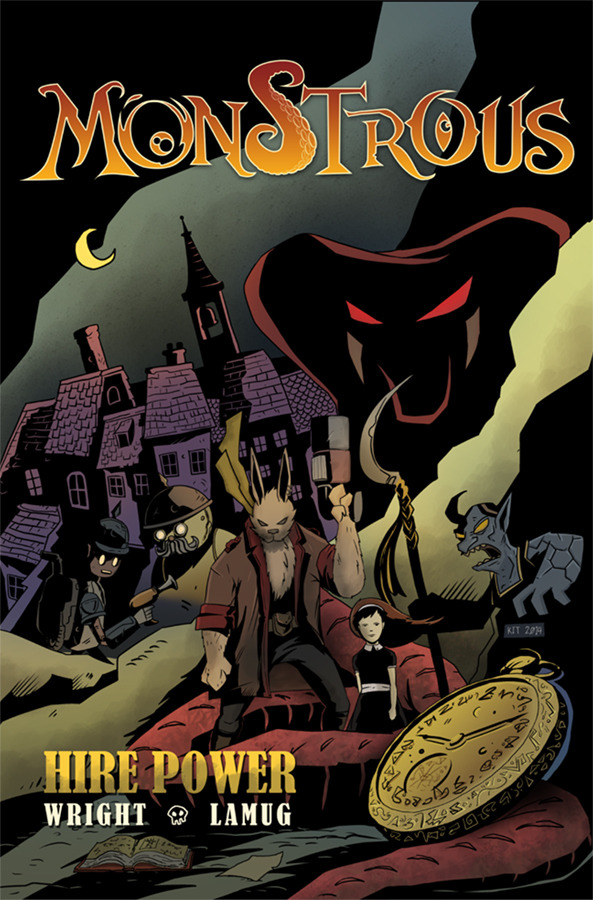








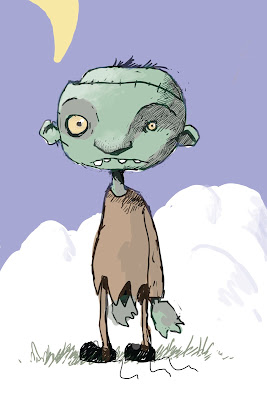




That is awesome! Congratulations!!! I signed up for the Goodreads challenge and set my goal at 50. I’m at 30 books now and fear that I won’t fit 20 in before the year is over. We shall see. I’m going to try and really push it to make it. I’ll keep your success in mind. Love that you broke the list down too! It’s a great way to determine what you love reading most and reminding yourself to keep your reading diverse. Great post!
Thank you so much, Beth! I’m glad that you liked my list: One of my goals was to be as diverse as possible in my reading. Remember: It ain’t over ’til it’s over. That noise you hear in the background is me cheering you on. Good luck!
Good luck!